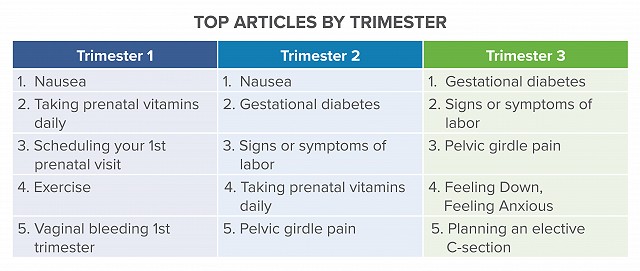Categories:

We Examined Mobile App Usage Of 23,000 Pregnant Women. Here’s What We Found.
By Charlotte Cesana, UX Researcher
Recently, we completed a quantitative analysis of content preferences among 23,000 of our most engaged pregnant users. These users engage with us via a mobile application that integrates and recommends resources from health plans, providers and employer groups.
At Wildflower, we are hyper-focused on user experience. Our technology is designed to personalize healthcare, to make it easier to navigate, to effectively engage and connect consumers to the information and resources they need to grow healthy families. If we don’t understand how users are interacting with our technology or what their experience feels like, we can’t be successful. In many ways, we are entering uncharted territory in healthcare, which makes it even more important for us to deeply understand what healthcare consumers want and need from the system, and how technology can give it to them.
As part of our user experience, we offer thousands of articles to our users, covering an exhaustive list of pregnancy-related topics. Our platform delivers these articles to women during their pregnancies through a dynamic, personalized newsfeed and searchable content libraries. These articles have two goals. The first is to educate the user on the topic at hand, and the second is to facilitate a connection with specific health resources as appropriate, based on what’s available to the user. For this research, we measured engagement within our content repository. We found some interesting patterns. Here are the highlights:
Understanding symptoms and issues is a critical need for users, especially early in pregnancy.
Half of our users access our symptoms and issues category within the app. Roughly one-third of users (32%) engaged with content that speaks to “what they are feeling.” This was followed by accessing test results and diagnostics (24%). The chart below breaks down engagement by category within symptoms and issues.
 Nausea tops our ranking for engaging articles, but results vary by trimester.
Nausea tops our ranking for engaging articles, but results vary by trimester.
When evaluating click rates for all content articles within the app, we see clear trends by trimester, In their first trimester, women are most interested in reading articles about healthy behaviors they can take such as exercise and taking prenatal vitamins daily. Nausea is top of mind in both 1st and 2nd trimesters. Physical symptoms and diagnoses are top of mind in Trimesters 2 and 3. Most of the top clicks concern articles related to physical health during pregnancy and connecting to care at the right time. The chart below outlines the top results by trimester.

You will notice topics like pelvic pain and signs of labor continue to increase in popularity as pregnancies advance. Also, in the third trimester, we see content related to feeling down or anxious hitting the top five, as a precursor to the post-labor concern of postpartum depression.
An Expected Shift as Pregnancies Progress
Over time, we see a predictable migration within active users from assessing symptoms to focusing on milestones. In the first trimester, activity around symptoms and issues is of critical importance to our users. As they progress through their pregnancies, users become much more focused on milestones related to a healthy pregnancy. The chart below tracks overall engagement by trimester for symptoms compared to milestones. As you can see, women shift from seeking to understand what they are feeling to managing how they are progressing in their pregnancies.

This type of insight is what we use to ensure our platform delivers the most useful content to our users at the time they find it most helpful. Creating a personalized journey for every user is why we are able to sustain engagement over time and drive healthy outcomes.
So, what’s next? We have a full research agenda planned for our user experience and will continue to share our latest insights via the blog and in other venues. If you want to learn more about our research process or other key learnings and best practices in digital health engagement, we’d love to hear from you. Reach out here.
